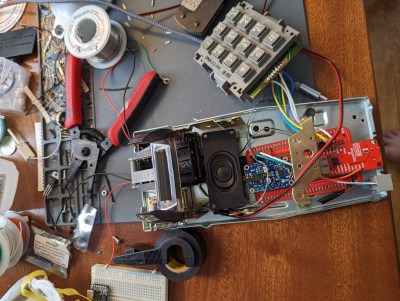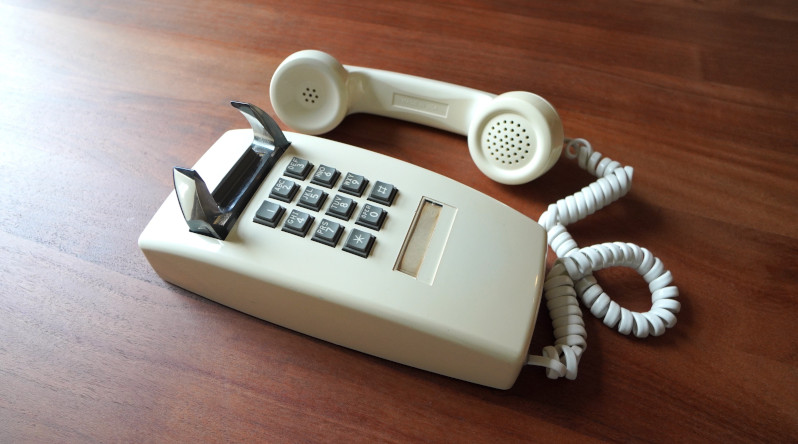Some guys get all the breaks. [Guy Dupont] had the honor of building a working, interactive wall-mount landline phone for the red carpet premiere of a certain TV show. The phone was to be an Easter egg inside an 80s-style pizzeria set. About every two minutes the phone would ring, and anyone brave enough to answer would be greeted with either a fake pizza order, an old answering machine message, or a clip from The Show That Cannot Be Mentioned.

So the phone doesn’t work-work, but the nostalgia is strong — picking up the receiver when the phone isn’t ringing results in a dial tone, and button pushing leads to the busy signal. Those old pleasant-but-stern operator recordings would have been cool, but there was only so much time. (Your call cannot be completed as dialed. Please check the number and try again.)
[Guy] used a SparkFun RP2040 to handle input from the DTMF keypad and play the tones, the dial and busy signals, and the various recordings into the ear of the receiver.
Instead of messing around with the high voltage needed to drive the original ringer and bell, [Guy] used a small speaker to play the ringing sound. Everything runs on eight AAs tucked under the keypad, which is stepped down to 5 V.
This project was built under fairly dramatic duress, which makes it that much more exciting to watch the build video after the break. With just five days to get the phone working and in the mail, [Guy] holed up on the floor of his office, his messy mid-move refuge from a house plagued by COVID. Unfortunately, the whole pizzeria thing fell through, so [Guy]’s phone will not get to have its moment on the red carpet. But at least it’s on the site that’s black and white and read all over.
[Guy] is no stranger to the old tech/new spec game. Remember that time he shoehorned Spotify into an iPod Classic?















Interesting design choices, why not just asterisk on a pi with an ata? The phone would have been left stock, and the call routing/operator messages could have been nailed too. You’d be done in a morning, I reckon.
I considered it! If this were permanently installed somewhere that would be a no brainer. I had no idea if I was going to be able to run power (or any cables) to the phone so ultimately I wanted something low(er) powered and fully self contained. The other nice thing about using a CircuitPython board is that the operator could very easily drop on sounds / configure parameters like volume and ring time over USB, even if they weren’t particularly technical.
I think it’s pretty cool build. The kind of phone you leave somewhere, add a sensor to trigger when somebody is in proximity and then a few creepy or disturbing messages and at some point they realize it’s not actually hooked up to anything…
I was thinking the same thing. You’d have the flexibility to swap out or add multiple phones quickly and easily.
That’s really cool and all, but why the trouble of installing all the stuff inside the phone?
The voltages of a real landline aren’t that dangerous, they’re still at the safe side on the edge of high voltage.
I mean, that’s why the telephone system had its own power. There’s not much current flowing.
Some Fritzbox or similar ADSL router has an analogue port with TAE or RJ11 connector. It’s not strong enough for a vintage phone with a rotary dial and mechanical bell, but should fine for all fax machines and electronic phones with an DTMF pad.
Okay, don’t get me wrong, I don’t mean to criticize the project. It’s fine and works as intended, so kudos. I’m just truely confused. That’s why comment, writibg down my thoughts. That’s what the comment section is for, I suppose.:
From my perspective, the world seemingly has changed so much. Things that used to be normal, trivial are now an event. I’m a 90s person, from Germany, not really old yet. It’s just that interfacing analogue telephones didn’t use to be a total nogo.
Not even with an ISDN system. Thanks to my father, programmer and business dude, we had an old Auerswald in-house landline at home. So we could reach and use multiple phones at home, including a base station of a wireless phone. We used to pre-dial “0” to dial outside of the house.
The system understood both pulse and tone dial, though we often used pulse dial, if memory serves.
Later on, my father and me built a little landline system (“house telephone”) as a hobby project. A few diodes, transformers, fuses and some unmodified phones from the local supermarket. Worked like a charm. Sure, there was no true ringing bell sound, but an ugly buzzing sound due to the cheap transformer circuit. And after a few months, the diodes would break eventually (too weak, we should have used stronger ones). But it worked fine from the living room to my DIY corner in the attic. In theory, it was good enough to connect two modems and do play some two-player modem games on two DOS PCs. 🙂
When you’re building something on an insanely tight deadline, you have to make a judgement call on the approach and whether you can achieve it in time, and then commit to it. There might be plenty of other options which could turn out easier, or they could put unforeseen stumbling blocks in place that eat up too much time and make delivery impossible. In the end you just have to go with what you already have experience with.
That makes sense. It’s confusing to people like me, though. That’s what I tried to explain. It wasn’t meant as criticism, at least not in a personal manner. It’s the nowadays situation we live in, rather.
For example, let’s take bicycle lights.
Nowadays, they’re all LED by default and must in my plave they must glow a litte longer even if the bike is standing still.
So what to do with old bikes?
a) Some people leave the old system as is and just install a separate LED lamp for bikes at the front and the rear.
In worst case, without knowing how to adjust the lamp for correct height. It will just blind others and doesn’t really help seeing the road.
Learning by doing, but the hard way.
b) Some people simply attach the dynamo to a new LED lamp. The result is an horrible flicker, because the dynamo makes AC, but the LED is a diode and only reacts when the AC has the right polarity for a moment.
Also, the LED goes out when the bike stands still.
c) Some a bit more technical inclined people will install a bridge rectifier to get rid of the LED flicker. Maybe install a capacitor as a buffer so the LED will glow a litzle bit longer once the bicycler stops riding the bike.
d) Some other people with life experience, maybe a bit like me, would hold breath for a moment and think about the situation. He/she/they will acknowledge that the light system is a vital part of safety and that it is equally important as on a car, a train, bus etc.
So he/she/they decides to just keep the previous system running as best as possible: keep the little incandescent lamp intact or if defective, replace it by another good one and install a bridge rectifier to the dynamo and a separate rechargeable battery pack or super cap for the side light.
That way, everything stays within spec, the reflector is still correctly adjusted in height, the light remains friendly to the eye (doesn’t blind others like super bright LEDs do).
PS: Sorry for rather poor English. It’s not my native language.